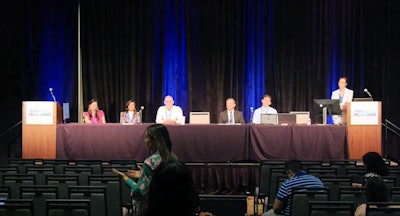
With physician burnout and radiologist shortages at all-time highs, radiology departments may want to consider implementing remote or hybrid work strategies, according to experts.
Radiology was already experiencing a shortage of radiologists and high rates of burnout before the COVID-19 pandemic. Yet the pandemic made matters worse. The result is one of the greatest challenges facing radiology leaders today -- the so-called "great resignation," a wave of retirements and job changes that have left most organizations short on staff.
To stem this tide, many radiology departments have adopted remote or hybrid remote work strategies.
"People are looking for a better way to live and a better way to work, and a way that integrates the things that are important to them in their practice," said Dr. Christine Glastonbury of the University of California, San Francisco in a session at the American Roentgen Ray Society 2023 annual meeting in Hawaii.
Glastonbury moderated a panel discussion titled, "Preserving Precious People: Stemming the Tide of the Great and Quiet Resignation." The topics covered how to retain staff as well as attract new hires. Implementing remote work strategies emerged as a major theme.
 Panelists during a session at ARRS 2023 discussed topics such as how to implement remote/hybrid work strategies for radiologists.
Panelists during a session at ARRS 2023 discussed topics such as how to implement remote/hybrid work strategies for radiologists.Dr. Brandon Brown of Indiana University suggested that leaders looking to implement remote or hybrid work strategies may want to first confront how comfortable they'll be with heterogenous solutions. Moreover, commoditizing reading skills can be dismissive of equally important noninterpretive skills, he said, and he noted that there are 160 radiologists in his department.
"We are all different and monocentric solutions won't work. If we're serious about it, we need solutions as diverse as our people," he said.
Brown added that the consolidation of health care systems is swinging the pendulum toward uniformity and conformity, and leaders now more than ever need to make a special effort to defend the need for diverse solutions.
Panelist Dr. Elainea Smith of the University of Alabama picked up this thread and stressed that providing a forum so that individuals feel their voice is being heard in key. She described joining her department's wellness committee a few years ago as the department was establishing strategies.
Early on, she was aware that several radiologists had already left because they wanted to work from home but couldn't. The biggest change they implemented was to provide staff with more autonomy by allowing them to control their own remote work schedules, even for just two or three days a week.
"Control of scheduling and autonomy plays a big role in satisfaction," she said.
Panelist Dr. Tabassum Kennedy of the University of Wisconsin-Madison added a point for radiologists facing increasing workloads with no solutions on hand. Employers may be taking advantage of your loyalty, she said. If that feels like the case, or if remote opportunities aren't offered, maybe it's time to "play hardball" and negotiate a higher salary, she suggested.
"Institutions don't love you back," Kennedy offered.
Still, not everyone can work remotely -- some people need to be onsite, according to Dr. John Leyendecker of the University of Texas Southwestern Medical Center. To that end, he suggested leaders should identify people who actually like to be there. This can stem feelings of inequity, he said.
Leyendecker added that there are other ways to incentivize more radiologists to work onsite. Radiologists who work onsite are going to produce lower relative value units (RVUs) than remote staff, yet both are needed, and so the idea of shared RVUs has been discussed openly in his department, for instance.
Other panelists included Dr. Ralph Drosten, a radiologist in private practice in Phoenix, AZ, who suggested that remote work may be exacerbating the lack of human interaction in radiology and that this may be reflected in reports. After all, human communication is 40% body language, he said.
New graduates considering a full-time work-from-home reading job might want to think again, Drosten suggested. While there was a glut of radiologists in the market in 2015, now most departments are facing shortages. This indicates that now could be the right time to find the right fit; five years from now the market could tighten up, he said.
Glastonbury added that among many new radiologists, remote reading work may be simply expected, more so because they arrived in the field during a time when remote reading strategies were being implemented to mitigate the spread of COVID-19.
On the other hand, existing staff may see remote work as a path to improved wellness, as a catalyst to "recalibrate" their careers to include more of what they really care about in their lives.
"We all want to do better when it comes to taking care of people -- the people that we work with every day, the people that we want to hire to work with every day, and the people that we know are unhappy working with us every day," Glastonbury said.
Remote and hybrid work strategies may be a start, she concluded.




















